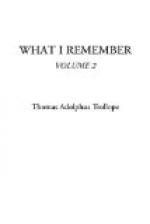But the condition of things in the other states of the peninsula, in Venice and Lombardy under the Austrians, in Naples under the Bourbon kings, in Romagna under the Pope, and very specially in Modena under its dukes of the House of Este, was much otherwise. In those regions the Italians were “thinking” a great deal, and had been thinking for some time past. And somewhere about 1849, those troublesome members of the body social who are not contented with eating, drinking, and singing—cantankerous reading and writing people living in towns, who wanted most unreasonably to say, as the phrase goes, that “their souls were their own” (as if such fee-simple rights ever fall to the lot of any man!)—began in Tuscany to give signs that they also were “thinking.”
I remember well that Alberi, the highly accomplished and learned editor of the Reports of the Venetian Ambassadors, and of the great edition of Galileo’s works, was the first man who opened my altogether innocent eyes to the fact, that the revolutionary leaven was working in Tuscany, and that there were social breakers ahead! This must have been as early as 1845, or possibly 1844. Alberi himself was a Throne-and-Altar man, who thought for his part, that the amount of proprietorship over his own soul which the existing regime allowed him was enough for his purposes. But, as he confided to me, a very strong current of opinion was beginning to run the other way in Florence, in Leghorn, in Lucca, and many smaller cities—not in Siena, which always was, and is still, a nest of conservative feeling.
Nevertheless there never was, at least in Florence, the strength and bitterness of revolutionary feeling that existed almost everywhere else throughout Italy. I remember a scene which furnished a very remarkable proof of this, and which was at the same time very curiously and significantly characteristic of the Florentine character, at least as it then existed.
It was during the time of the Austrian occupation of Florence. On the whole the Austrian troops behaved well; and their doings, and the spirit in which the job they had in hand was carried out, were very favourably contrasted with the tyranny, the insults, and the aggressive arrogance, with which the French army of occupation afflicted the Romans. The Austrians accordingly were never hated in Florence with the bitter intensity of hate which the French earned in the Eternal City. Nevertheless, there were now and then occasions when the Florentine populace gratified their love of a holiday and testified to the purity of their Italian patriotism by turning out into the streets and kicking up a row.




